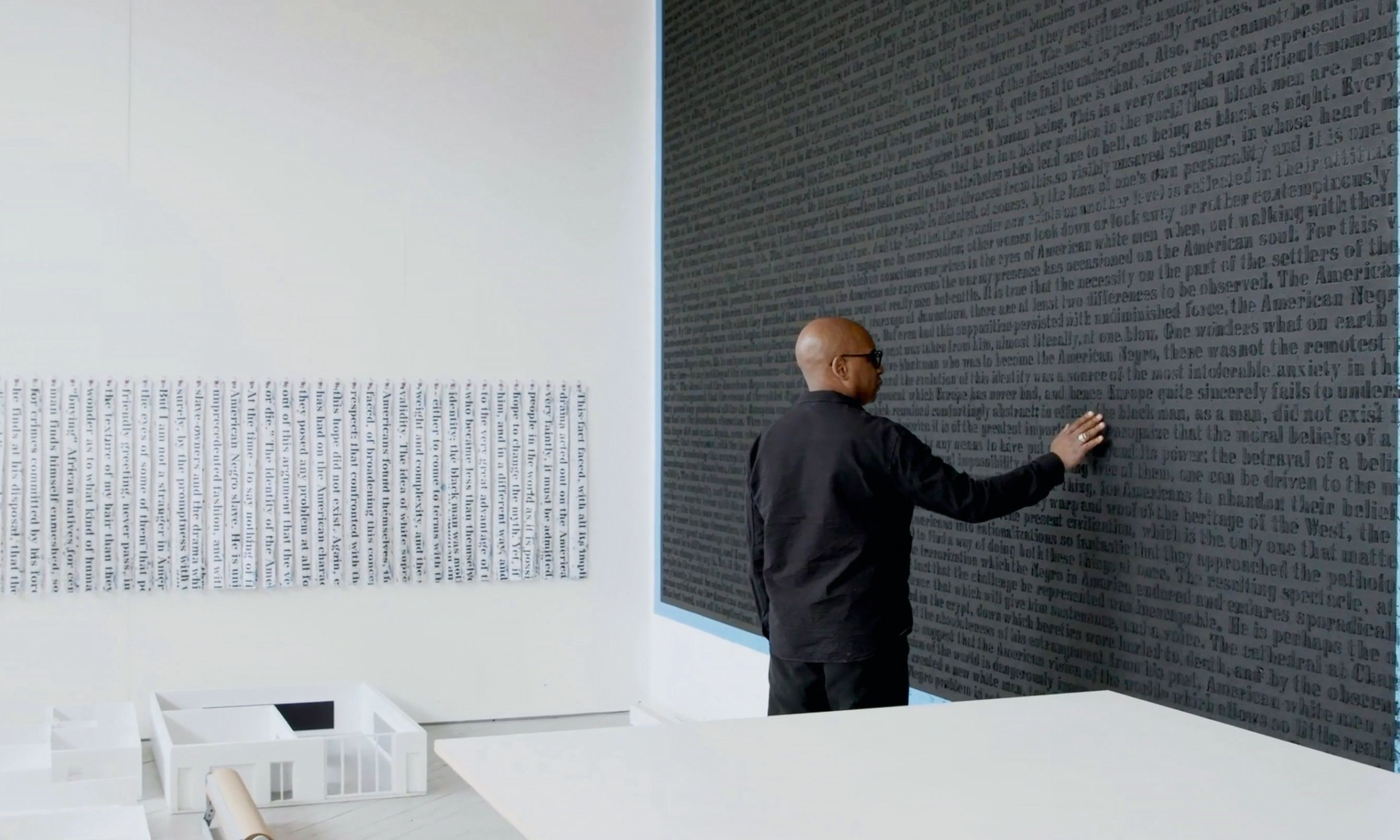Glenn Ligon with part of the Stranger series, which spotlights an essay by the writer James Baldwin © Glenn Ligon; courtesy the artist and Hauser & Wirth
For his first solo exhibition in Hong Kong, the US artist Glenn Ligon has produced several new paintings that expand on his celebrated Stranger series, which began in 1997. The works on show at Hauser & Wirth Hong Kong are based on James Baldwin’s 1953 essay Stranger in the Village, in which the writer reflects on his encounter with the inhabitants of a Swiss mountain village who had never met a Black person before. Ligon’s powerful compositions explore the visibility and invisibility of the Black experience, stencilling Baldwin’s words on the canvas and coating them with coal dust. Ligon tells The Art Newspaper about the beginnings of the series and how it has developed further over the past two decades.
Glenn Ligon first encountered James Baldwin's work in an African American literature class in college Courtesy the artist and Hauser & Wirth
The Art Newspaper: When did you discover Stranger in the Village and what impact did it have on you?
Glenn Ligon: I first encountered the essay in an African American literature class in college. It resonated with me because it seemed to mirror my own biography and upbringing. I transferred from a public school in the South Bronx to an elite private school on the Upper West Side of Manhattan in the first grade. That disconnect between the world I was inhabiting in school and the world at home, and the notion of being a stranger in those white spaces, was something that I subconsciously related to when I first read the essay. But that was before I knew I would be an artist.
How did you come to your choice of medium for the series?
Baldwin wrote in a very elaborate style: paragraph-long sentences on dense, weighty topics like colonialism, racism and queerness. I wanted the material density of the paintings to match the density of his writing. Coal dust is a waste product from coal processing. The name alone has fantastic metaphoric associations, but I also liked the material—black, shiny gravel. Baldwin talks about how the place of the “disesteemed” is where you learn the most about how a society functions. The idea of coal dust, a waste product, elevated into the space of art was something that interested me. When I started using excerpts of text in the paintings, the coal dust I added on top simultaneously amplified and obscured Baldwin’s words. The legibility and illegibility of the text is what the work is about—the struggle to decipher something and find meaning.
Glenn Ligon’s Static #8 (2023), which will be on show at the Hauser & Wirth gallery in Hong Kong until 11 May Photo: Ronald Amstutz; courtesy the artist and Hauser & Wirth
Now that you have spent more than two decades working with the text, what new meanings have emerged?
When I first started the series, Baldwin wasn’t ubiquitous like he is now. In the beginning, my project was about the resurrection of Baldwin’s work. At the end of his life, he was not on the public’s mind. His works had gone out of favour and he was not the spokesperson for Black America that he was in the 1960s and 70s. I was in a studio programme at the Whitney Museum in 1984 talking to my roommate about our readings—Foucault, Baudrillard and all these other French philosophers. I said I had been digging into Baldwin’s essays as a palate cleanser. She said, “Who’s that?” It’s not that she hadn’t read Baldwin: she didn’t know the name. That’s when I started thinking I could use my work as a platform to reintroduce art audiences to figures like Baldwin.
The early paintings in the Stranger series were smaller, starting at the beginning of the text. How has your approach changed with each cycle of paintings?
The first works that used the entire essay were made [in 2020-21] for Hauser & Wirth in Zurich. It took me 20 years to get there. I was interested in making canvases that engulf the viewer. Stranger in the Village tackles so many different subjects in its ten or so pages, like Europe’s relationships to its colonies in Africa, cultural domination and the notion of otherness. The essay itself is very panoramic in its scope and that was reflected in the full text painting. Now when I work with the essay I use it more like a ground. It’s important that it’s there, but it’s the base upon which the painting gets built.
What are some considerations you or the gallery made for exhibiting the series in Hong Kong, where Baldwin’s work may be less familiar?
Not everyone in America knows Baldwin either. People approach artworks with different levels of knowledge. Usually, the more you have, the better. But—and I don’t want to seem like I’m bragging—the paintings are quite beautiful, which draws people into the work. When I was younger, I would go to the Metropolitan Museum of Art and wander through the Islamic wing. I don’t read or speak Arabic, but I was fascinated by the calligraphy, particularly the beautifully rendered passages from the Quran. I didn’t have access to the language that was on these pages but knew it was the Quran, and I was appreciating those pages as beautiful devotional objects. Their beauty was part of their power.
• Glenn Ligon, Hauser & Wirth Hong Kong, G/F, 8 Queen’s Road Central, Central, until 11 May
• Glenn Ligon, Distinguishing Piss from Rain: Writings and Interviews, edited by James Hoff, will be published by Hauser & Wirth on 25 June

